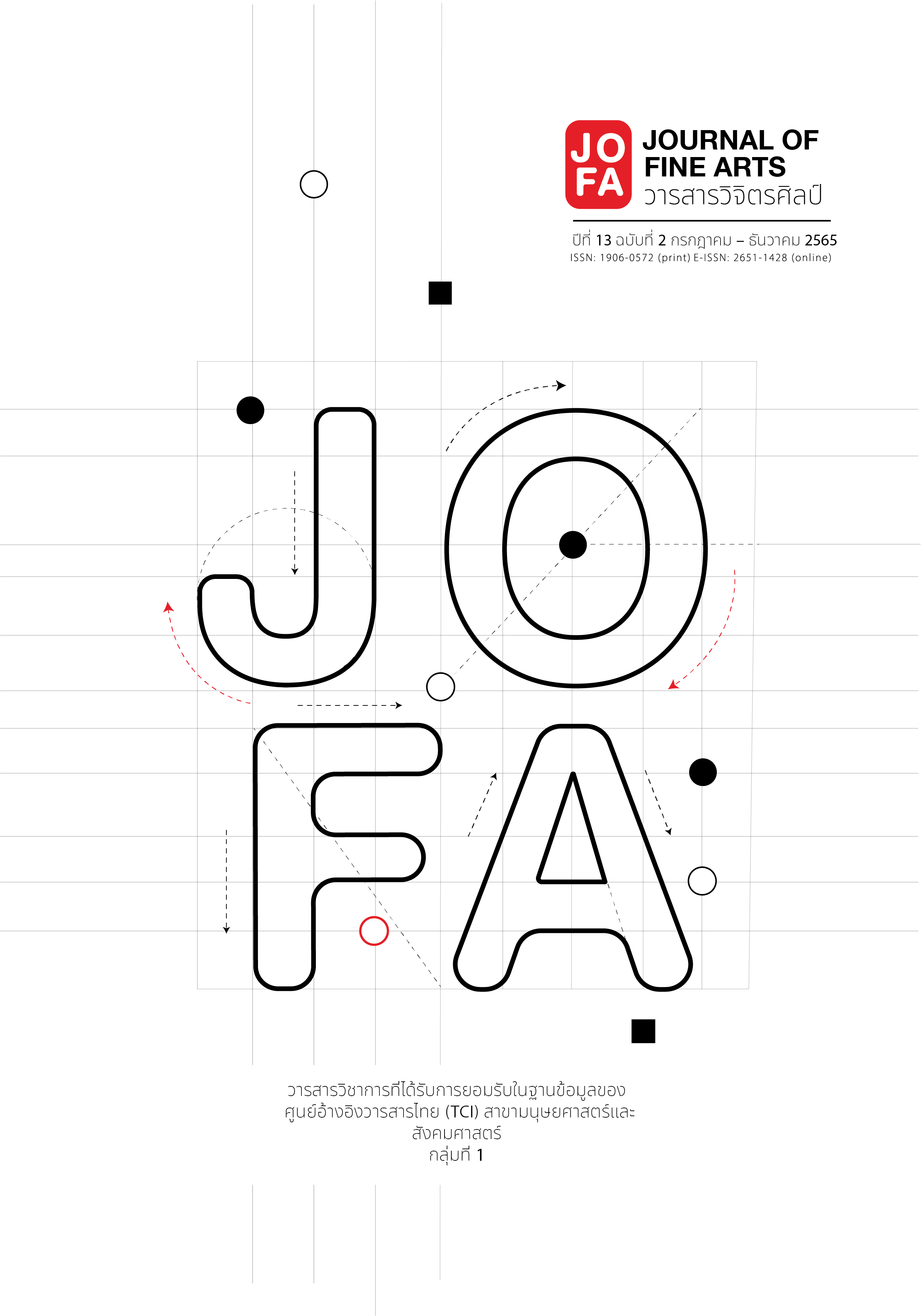Royal Style Art in Thonburi Thai Temples to The Creation of Contemporary Painting
Main Article Content
Abstract
This research aimed study royalism art to draw conclusions of the form of creation of royal style art works, study contemporary art to summarize the findings of contemporary art forms of creation and create contemporary paintings inspired by royal style art in the reign of King Rama III. The researcher studied royalist art in five Thai temples in Thonburi that constructed according to the royal style and built by kings, royal families, nobles and common people, which consider very informative cases, namely Wat Ratchorasaram Ratchaworawihan, Wat Nang Nong Worawihan, Wat Kalayanamit Woramahawihan, Wat Sawetachat Worawihan. and Wat Prasert Sutthawat. Then, the researcher had created a sketch of the painting and interview form. The interviews were conducted on independent artists, Art teachers and art scholars. Visual arts theories and criteria for assessing the quality and value of painting. (Soonpongsri 2016, 211 - 294) were applied into interview form and used as a criterion for assessing the quality and value of painting. Descriptive analysis was used.
The findings of quality and value assessment of the contemporary painting inspired by the influence of royal style art during King Rama III’s reign revealed that this set of contemporary paintings reflects all 3 values. 1) The aesthetic value; the composition was appropriate with the forms in which derived from architectural structure and pattern of the unique Thai - Chinese blended culture. 2) The emotional value; the paintings were impressive and appreciative for the past glory. 3) the conceptual value; the paintings were meaningful presenting the prosperity of Buddhism and the relationship between Thai and China even though the economic side was not so clearly showed in the paintings. All three of aesthetic, emotional and conceptual values shown in this set of paintings could be reflected the unique beauty influenced by Royal style art of Thai temple in Thonburi area. It was the classical and timeless beauty, worthy of awareness to be knowledgeably collected and pass on to the next generation.
Article Details

This work is licensed under a Creative Commons Attribution-NonCommercial-NoDerivatives 4.0 International License.
References
Leksukhum, S. Khwāmsamphan Čhīn - Thai Yōng Yai Lūatlāi Pradap. [China - Thailand Relations Unite the decorative pattern]. Bangkok: Ancient City Publishing House, 2007.
Luechaphatthanaporn, S. Sān sin Čhīn - Sayām. [San Silpa, China - Siam]. Bangkok: Chulalongkorn University Book Center, 2005.
Nuansawat, A. Sinlapa Rūamsamai Thai: Samnakngān Sinlapa Watthanatham Rūamsamai Krasūang Watthanatham. [Thai Contemporary Art: Office of Contemporary Art and Culture. Ministry of Culture]. Bangkok: Rungsilp, 2015.
Office of Contemporary Art and Culture Ministry of Culture. Nayōbāi læ konlayutthasāt Songsœ̄m Sinlapa Watthanatham rūamsamai (Phō̜.Sō̜. 2013 - 2017). [Policy and Strategy to Promote Contemporary Art and Culture (2013 - 2017)]. Bangkok: Office of Printing Business. The War Veterans Organization of Thailand, 2017.
Panyapetch, C. “Sinlapa Rūamsamai Thai Phāitai Nǣokhit Lang ʻānānikhom Nai Thotsawat Thī 1990. [Thai contemporary art under the post-colonial concept of the 1990s].” Journal of Fine Arts 6, no. 1 (January/June 2015), 86 - 91.
Phakdeekham, S. and Phakdeekham, N. Sœ̄m Siri mongkhon yon Sinlapa Čhīn Na Wat Thai nai Krung Thēp. [Serm-prosperity Chinese art at a Thai temple in Bangkok]. Bangkok: Amarin, 2010.
Soonpongsri, K. Suntharīyasāt: Lak Pratyā sinlapa Thritsadī sin Sinlapa wičhān. [Aesthetics: Philosophy of Art, Art Theory, Art Criticism]. 3rd ed. Bangkok: Chulalongkorn University, 2016.
Sriyanalak, K. “Kān Sư̄ Khwāmmāi Khō̜ng Phāp Mongkhon Čhīn. [Interpretation of Chinese auspicious images].” Journal of Chinese Studies 4, no. 4 (April 2011): 22 - 43.
Tangchalok, I. Nǣothāng Kānsō̜n Læ Sāngsan Čhittrakam Khansūng. [Guidelines for Teaching and Creating Advanced Painting]. Bangkok: Amarin, 2007.


